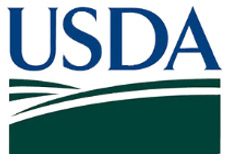On-Farm Compost Regulatory Overview
California's Healthy Soils Initiative
State and Regional WaterBoards
Water Board regulatory requirements for on-farm compost operations depend on whether the site is a non-dairy agricultural site or a dairy. For many operations,composting on-farm may be exempt from requiring additional permitting if it meets certain conditions.
Exemption: Non-dairy agricultural sites do not require a water board permit under the Compost General Order if:
- Feedstocks include only agricultural material and green materials.
- Less than 25,000 cubic yards of feedstock, composting material, and finished compost is on site at any one time.
- Less than 5,000 cubic yards of finished compost is sold or given away per year and the remaining is returned to land owned by the same farmer (please see information below if the composting operation will be owned by a co-op).
- Composting activities are at least 100 ft from the nearest surface water body and/or the nearest well
- Discharge of wastes that may adversely impact water quality is minimized and application of water (including rain) is managed to reduce the generation of wastewater.
- Working surfaces (for composting and storage) are designed to prevent ponding, runoff, infiltration, erosion, inundation, etc.
Composting permit: A composting permit (same as commercial composting facilities) may be required if the compost operation fails to meet any of these thresholds.
Dairy sites issued an individual permit or enrolled in a general order that includes requirements for manure management can accept agricultural material from offsite and can compost and give away or sell as much finished compost as desired.
As with any soil amendment or fertilizer, the application of finished on-farm compost to fields may be subject to Water Board Irrigated Lands Regulatory Program requirements (e.g. measurement and reporting of compost nitrogen applied, carbon to nitrogen ratio, etc.)
Cal Recycle/Local Enforcement Agencies
On-farm compost operations will most likely either be excluded from Cal Recycle’s composting regulations or require notification to your local enforcement agency (LEA).
Excluded activities: Agricultural composting is excluded from Cal Recycle’s composting regulations (exact exclusion language here) as long as:
- It handles only agricultural material.
- Agricultural material must be derived from an agricultural site(s) owned or leased by the compost operation owner, parent, or subsidiary.
- Less than 1,000 cubic yards of compost product is sold or given away annually with the remainder returned to the same site(s).
Notification Tier: An agricultural composting operation must notify their LEA if the following parameters are met:
- It proposes to handle only agricultural material and green material.
- It plans to sell or give away more than 1,000 cubic yards annually.
To fulfill notification requirements, operators may submit Cal Recycle form 169 or send a letter with the same information to their LEA (list of LEA contacts found here). The full filing requirements for the Notification tier are found here.
- Be sure to confirm directly with the LEA that the proposed composting operation fits the notification tier criteria
Other: If the site does not meet the requirements as discussed above, then the project proponent should reach out to their LEA regarding regulatory requirements.
Air Districts
Air regulations differ by air district and apply to the site where composting will occur. You can use this map to find out which air district regulates the proposed compost operation site.
In general, on-farm compost operations will be exempt or require a pre-construction permit and possibly the purchase of offsets. These requirements will be based on the estimated emissions of volatile organic carbons (VOC). This estimate depends on:
- the type of material being composted; primarily, if one of the feedstocks is manure
- amount of material composted annually
- planned control measures (see on-farm compost regulatory requirement tool for more information)
Agricultural Exemption: Some air districts have limited agricultural exemptions that waive the need for a pre-construction permit if certain requirements are met.
- You may use the on-farm compost regulatory requirements tool to determine if an on-farm compost operation would meet exemption requirements in your air district.
Pre-Construction Permit: Air district regulations will most likely require new emission sources, including on-farm composting operations that do not meet the limited agricultural exemption requirements, to receive a pre-construction permit.
- This permit will require identifying information such as the composting site location, expected feedstock (type, annual volume), details on how compost will be created, and the control measures you intend to employ to reduce emissions.
- Some of these items are explained in the On-Farm Compost Regulatory Requirements Tool. Full details should be requested directly from your air district. Find your Air District at California Air Districts | California Air Resources Board.
Offsets: If the estimated emissions exceed the air district-specific threshold for VOC emissions, the operation may need to purchase offsets in addition to submitting a pre-construction permit.
- In this case, air districts may also require the implementation of more extensive control measures called best available control technology (BACT).
The On-Farm Compost Regulatory Requirements Tool may be used to understand if an on-farm composting operation meets agricultural exemption requirements, requires a pre-construction permit, or would necessitate purchasing offsets in each air district.
Guidelines for Odor Control (Not Required): Many of the best management practices (BMPs) for odor control – including compost caps and wetting after turning – are considered BMPs for VOC emissions reduction as well.
- BMPs are specific to the phase of the composting process – receiving materials, grinding, mixing, composting, curing, and runoff - and generally center around maintaining appropriate moisture contact and avoiding dust.
- While these guidelines are not generally required, your CalRecycle LEA may require implementation of some of these measures if they receive specific complaints regarding odor.
Collaborative Ownership "Co-op" Model for On-Farm Composting:
Below are some of the existing regulations related to compost operation ownership:
- An activity is excluded if it handles agricultural material, derived from an agricultural site, and returns in similar amount of the material produced to the same agricultural site, or an agricultural site owned or leased by the owner, parent, or subsidiary of the composting activity
- "Owner" means the person or persons who own, in whole or in part, a compostable material handling operation or facility, or the land on which these operations or facilities are located.
Pursuant to that language, an entity owned by a group of cooperating farmers and ranchers could meet both the CalRecycle and Water Board agricultural exemptions for compost if:
- compost agricultural materials provided by group members on an agricultural site owned by- or leased to- that group, and
- distribute final compost in any amount among the part owners of the composting entity
All of the same requirements would apply to a group operating a compost operation as an individual farmer or rancher. View examples that apply here
For air districts, each site where composting occurs would need to be individually permitted as a new source of emissions by their local air district regardless of ownership. The VOC offset thresholds apply to each site / new source regardless of ownership structure so long as the sites are non-contiguous
Definitions
- Agricultural Material: Agricultural material (vegetative and woody) or manure created as a byproduct of agricultural production. The full definition of agricultural material is found here.
- Agricultural Site: Site zoned for agricultural use with at least some portion used for agricultural production and thus contributing agricultural materials to the composting operation
- Compost: The product of controlled aerobic, biological decomposition of materials such that the carbon is stabilized and the viability of pathogens and weed seeds have been reduced
- Contiguous or Adjacent Property: A property consisting of two or more parcels of land with a common point or boundary or separated solely by a public roadway or other public right of way
- On-Farm Compost Collaborative or Cooperating Group: On-farm composting operation owned by a group of farmers or ranchers who contribute agricultural material to be composted at an agricultural site owned by or leased to the group
Application and Documentation Information: Below are the types of information that will be helpful in maintaining regulatory compliance for an on-farm compost operation.
| Regulatory Body | Form and Timeline | Prior to Operation (Information & Timeline) |
Ongoing Documentation |
|---|---|---|---|
| Water Board [Documentation should be available if requested] |
A full list of requirements , if not exempt, can be found here | Nothing to submit if the proposed operation meets exemption requirements |
|
| CalRecycle [Documentation must be available for annual review] |
CalRecycle Form 169 or in a letter (if not an excluded activity) A full list of filing requirements can be found here |
|
|
| Air Districts
[Documentation should be available if requested] |
Forms are Air District Specific** |
|
|
* See examples of process documentation in the food safety section
** See Air District contact list in the resources section





